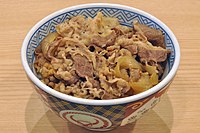
Photo from wikipedia
With application of PLS regression and SVR, quantitation models of near infrared diffuse reflectance spectroscopy were established for the first time to predict the content of volatile basic nitrogen (TVB-N)… Click to show full abstract
With application of PLS regression and SVR, quantitation models of near infrared diffuse reflectance spectroscopy were established for the first time to predict the content of volatile basic nitrogen (TVB-N) content in beef and pork. Results indicated that the best PLS model based on the raw spectra showed an excellent prediction performance with a high value of correlation coefficient at 0.9366 and a low root-mean-square error of prediction value of 3.15, and none of those pretreatment methods could improve the prediction performance of the PLS model. Moreover, comparatively the model obtained by SVR showed inferior quantitative predictive ability (R = 0.8314, RMSEP = 4.61). Analysis on VIP selected wavelengths inferred amino bond containing compounds and lipid may play important roles in the development of PLS models for TVB-N. Results from this study demonstrated the potential of using NIR spectroscopy and PLS for the prediction of TVB-N in beef and pork while more efforts are required to improve the performance of SVR models.
Journal Title: Meat science
Year Published: 2021
Link to full text (if available)
Share on Social Media: Sign Up to like & get
recommendations!